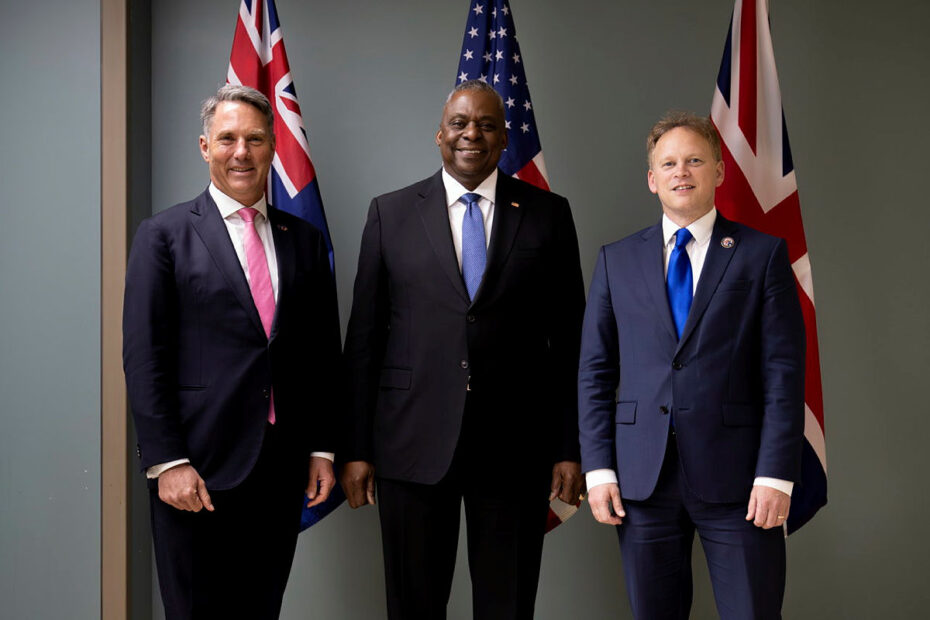In a pivotal joint press briefing on December 1, 2023, AUKUS defence ministers addressed the media. Secretary of Defence Lloyd J. Austin III stood for the United States, while Australian Deputy Prime Minister and Minister for Defence Richard Marles and the UK Secretary of State for Defence Grant Shapps, stood alongside him at the Defence Innovation Unit Headquarters in California.
This significant gathering marked a crucial moment in the ongoing collaboration under the AUKUS framework. The AUKUS defence ministers discussed a wide array of strategic initiatives, emphasizing the alliance’s commitment to security, Defence innovation, and regional stability.
Their joint press briefing supplied insights into the progress made within the alliance since its inception in 2021, showcasing the unity and determination of the AUKUS member nations to address shared security challenges. As the Indo-Pacific region sees dynamic geopolitical shifts, the AUKUS defence ministers affirmed their dedication to fostering innovation and advancing innovative capabilities.
The AUKUS Pillar 2 focuses on leveraging defence innovation and industry sectors to develop and deliver advanced capabilities, with a particular emphasis on technologies such as artificial intelligence (AI), quantum technology, and electronic warfare (EW). What is highlighted in their joint press briefing is the growing need for and importance of staying ahead in the EW domain, which is clear in their commitment to innovation and collaboration under AUKUS Pillar 2 of the alliance.
In the dynamic realm of naval warfare, submarines stand as linchpins, safeguarding nations’ security and strategic interests. Evolving technology propels submarines to employ sophisticated tools and tactics, with EW appearing as a pivotal part. In the submarine context, EW uses the electromagnetic spectrum to gain a strategic edge, encompassing activities like detecting, deceiving, disrupting, or destroying enemy sensors and communication networks.
A crucial side of submarine EW is Electronic Support Measures (ESM), involving passive collection of electronic signals emitted by potential threats. ESM enables submarines to detect and find adversaries by analysing the electromagnetic environment. For instance, submarines equipped with advanced ESM can intercept radar signals from nearby surface ships, extracting vital intelligence while maintaining stealth.
Electronic Countermeasures (ECM) form the active side of EW, engaging when a threat is detected. Submarines use ECM systems to disrupt or deceive adversary sensors, deploying electronic decoys or jamming devices to divert attention and evade detection. In the depths where traditional communication is challenging, submarines heavily rely on EW for secure and stealthy communication. Advanced EW systems enable encrypted communication links, ensuring secure exchanges with command centres or other submarines.
Integration of AI and machine learning enhances adaptability to evolving threats. Quantum technologies promise unhackable communication channels, reinforcing submarines’ secure information exchange. The AUKUS nations are at the forefront of these advancements, contributing significantly to EW capabilities. This synergy within the AUKUS partnership is poised to bolster defence strategies, amplifying effectiveness in the free and open Indo-Pacific. In the evolving landscape of undersea warfare, EW remains a cornerstone, empowering submarines as potent instruments of national security.
China’s strategic investments in EW underscore its recognition of modern conflict dynamics and geopolitical challenges. Prioritizing EW advancements aligns with China’s goal to shape the battlefield, secure interests, and assert dominance in 21st-century warfare. Robust EW enhances strategic deterrence by introducing complexity, contributing to China’s global influence aspirations.
The shift in military strategy emphasizes EW’s critical role, providing an asymmetric advantage against adversaries. Investments align with broader modernization efforts, addressing technological gaps and countering superior adversaries. In regional disputes like the South China Sea, EW safeguards China’s territorial claims, while cyber integration enhances hybrid warfare capabilities. EW is integral to China’s Anti-Access/Area Denial strategies, restricting adversary movements in contested areas.
AUKUS places a significant emphasis on collaborative defence innovation, particularly in the realm of EW. In this dynamic partnership, the three nations pool their abilities and resources, fostering the development of cutting-edge EW capabilities. This collaboration ensures that advancements made by one member nation benefit all, creating a synergistic effect that propels EW capabilities forward.
In the Indo-Pacific region’s dynamic geopolitical landscape, EW has emerged as a crucial component of defence strategies, especially in countering China’s growing influence. The expansive maritime territories of the Indo-Pacific witness increased military activities, necessitating robust EW capabilities for a secure and stable environment. AUKUS nations lead the integration of AI into military technologies, including EW. AI enhances the speed and efficiency of EW systems, enabling swift responses to emerging threats. By sharing advancements in AI-driven EW, the alliance collectively stays ahead of adversaries, adapting to evolving EW landscapes.
AUKUS members will collaborate on developing advanced ESM systems to detect and locate potential threats, contributing to a comprehensive understanding of the electromagnetic environment. AUKUS will facilitate joint efforts in developing sophisticated ECM systems, such as electronic decoys and jamming devices. Collaboratively, member nations create robust countermeasure solutions, improving platform survivability in contested environments.
Secure communication is paramount in military operations, particularly for submarines operating in challenging underwater environments. AUKUS will promote the development of secure communication technologies using EW advancements. This will ensure reliable and covert communication channels, enhancing coordination and strategic capabilities. AUKUS will further foster common standards and interoperability in EW systems, crucial for seamless collaboration during joint operations. Common standards ease EW integration across diverse platforms, ensuring a cohesive and effective approach to countering threats.
In the maritime domain, where China asserts territorial claims, EW plays a pivotal role in safeguarding naval assets. Submarines, vital to naval fleets, rely on electronic systems for communication and stealth. Advanced EW capabilities thwart China’s attempts to detect, track, or target submarines, preserving AUKUS nations’ strategic advantage.
China’s investments in advanced sensor networks pose challenges to traditional military operations. EW techniques, including jamming, spoofing, and signal manipulation, become imperative to counter and neutralize these sensor networks, protecting AUKUS assets and maintaining operational secrecy. Robust EW capabilities contribute to strategic deterrence by complicating China’s decision-making processes, reducing the predictability of AUKUS military actions. Disrupting communication and intelligence networks adds complexity, dissuading aggressive actions and promoting regional stability.
EW is instrumental in securing communication channels for coordinating military operations. AUKUS nations, operating in the vast Indo-Pacific, rely on secure communication systems for effective command and control. Advanced encryption, anti-jamming technologies, and secure satellite communication are vital components. Integration of cyber capabilities into EW addresses the evolving nature of modern threats. AUKUS fortifies defences against cyber-attacks, encompassing cyber resilience and offensive cyber capabilities to mitigate threats posed by China.
AUKUS collaboration in EW not only strengthens individual nations’ capabilities but also enhances alliance cohesion and interoperability. Fostering regional stability, AUKUS serves as a deterrent to potential Chinese aggression, highlighting the significance of EW in the Indo-Pacific security architecture. As information dominance becomes crucial in modern warfare, China’s focus on controlling the information spectrum is evident. EW investments secure control over communication channels, disrupting adversary intelligence networks and ensuring China’s upper hand in the information domain.
As technological advancements shape the future of warfare, AUKUS’ commitment to innovative EW capabilities ensures it remains at the forefront of regional security, deterrence, and stability. China’s substantial investments in research and development propel its EW capabilities forward. Prioritizing scientific and technological advancements aligns with China’s strategic objectives, fostering innovation and developing EW technologies. AUKUS’ emphasis on EW in its strategic considerations is undoubtedly shaped by the need to counter China’s significant advancements in this field. China’s heavy investments in EW capabilities aim to disrupt and neutralize technological advantages held by potential adversaries, including AUKUS nations.
China’s multifaceted strategic focus on EW involves developing technologies to disrupt communication systems, jam radar signals, and interfere with unmanned aerial vehicles. The integration of cyber capabilities enhances China’s ability to engage in hybrid warfare. For AUKUS, investing in EW capabilities serves as a strategic deterrent against potential adversaries. By developing innovative technologies and fostering interoperability, the alliance aims to create an environment where any adversary, including China, thinks twice before engaging in aggressive actions in the Indo-Pacific region.
In conclusion, the AUKUS alliance’s emphasis on EW reflects a strategic response to the changing dynamics of global power. The collaborative efforts of Australia, the UK, and the US in this domain send a clear message about their commitment to be keeping a technological edge, countering potential adversaries, and ensuring a secure and stable Indo-Pacific region in the face of evolving geopolitical complexities.




